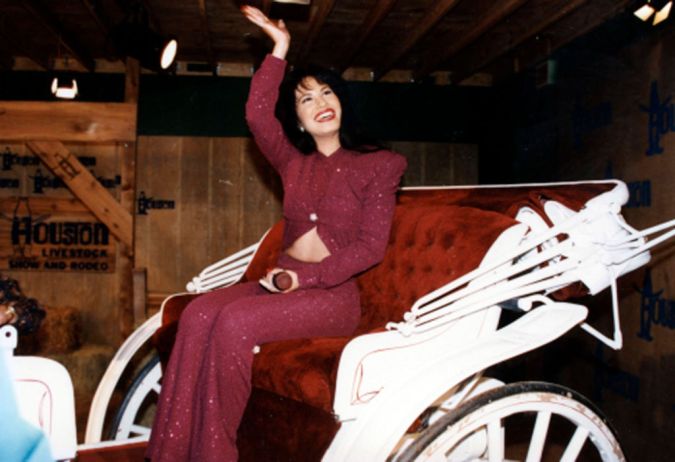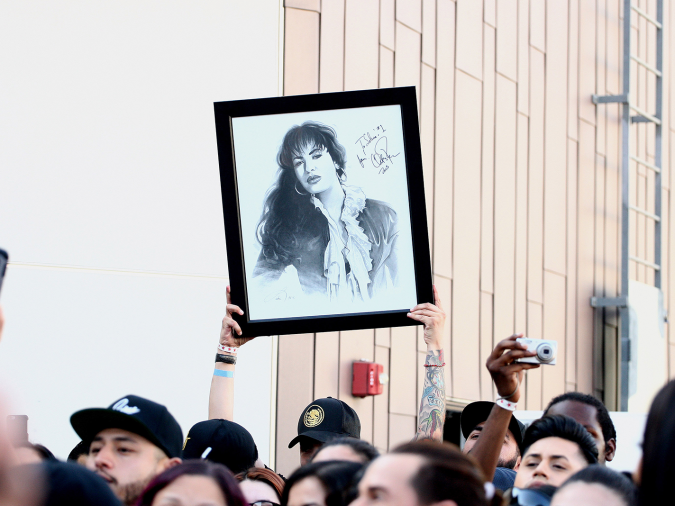At 11, I was a friendless, pudgy nerd with unruly dark hair and oily, olive-toned skin who was relentlessly bullied at my Catholic school.
While my 6th-grade Latina classmates in Union City, New Jersey, obsessed over Jennifer Aniston’s iconic Rachel haircut on Friends or listened to TLC and En Vogue, I preferred Gloria Estefan, Celia Cruz, and Julio Iglesias. I also spent hours watching Spanish-language soap operas with my grandmother. Needless to say, I wasn’t the class trendsetter.
But then one night while I was channel-surfing with my grandmother, a young woman with a bombastic voice, megawatt smile, and shapely curves graced the television screen. Her name, I learned, was Selena Quintanilla, and she was the “Queen of Tejano music.” By that weekend, I bought CDs and cassette tapes of her Amor Prohibido and Entre a Mi Mundo albums.

Selena may have been raised in Texas by Mexican parents, and I may have spent most of my childhood in Northern New Jersey, and my summers in Miami, with my extended Cuban family, but I felt an instant connection to her. I had found someone that I could look up to.

Because I wasn’t usually invited to birthday parties or sleepovers, I spent a great part of my weekends dancing around the living room. Now, in addition to creating choreographed routines for Madonna’s “Like a Prayer,” I switched up my repertoire, and began belting out my favorite Selena song, “Bidi Bidi Bom Bom.”
Selena’s music became a refuge, but more than that, she became a role model. She was unapologetically Latina, talented, and beloved—a contrast to the isolation I felt at school. While I had no dreams of being a singer, I longed for her confidence, warmth, and how she could light up a room.
At Saint Augustine School, I mostly kept quiet at lunch or between classes to avoid the relentless bullying that would leave me with anxiety, constant nausea, clammy hands, and a sense that I had very little value.

But when one student asked what I did one weekend, I excitedly blurted out that I’d watched Selena sing on TV. Without knowing it, it would be her last concert, the one at the Houston Astrodome, where she donned her iconic sparkly purple one-piece. She danced and smiled, and I tried to mimic her moves from my bedroom. I mentioned that I wanted to be like her.

The response was swift and cruel. They mocked my appearance, comparing me unfavorably to Selena and invented a demeaning nickname. Classmate after classmate piled on, sensing an opportunity to knock me while I was down. “We’re going to start calling you ‘Carmen-less, because you’re car-less and men-less,” they said. The words stung, but something shifted within me.
Comments like these would have typically sent me crying to the girl’s bathroom. This time, the incessant name calling sparked a fire of indignance grew in me, and I could feel my cheeks glowing red with anger. For the first time, I felt a flicker of the same strength I saw in Selena. I spoke up, pushing back against their taunts.

Some of the girls looked shocked, some laughed, and one made a comment under her breath, but for the first time, they let me be. Selena sparked in me a sense of confidence I hadn’t experienced before.
Less than a month after that interaction, Selena Quintanilla was murdered. Like many fans, her death felt unbearably painful and lonely. She was the only one I could identify with at the time. And before an era of cell phones and social media, I’d have to wait to get home and turn on the TV if I wanted to know about current events.
By the time I walked the block and a half from my parochial school that balmy Friday, March 31, 1995, I was greeted on the front porch by my maternal grandmother, Juana. She was normally smiling and had treats for me, but instead, she stood cross armed, with tears welling in her eyes. She then broke the news about Selena’s passing.

Then came the non-stop coverage, something that still continues to this day when we get close to the anniversary of her death or her birthday on April 16.
It wasn’t just Univision or Telemundo that had nonstop coverage of Selena’s death and the standoff with her murderer, Yolanda Saldívar. I tuned in to English-language stations like NBC and CBS and they were covering this breaking news, too. Because it wasn’t just Latine people that were grieving Selena’s death. It was the whole country.
In the days that followed, I mourned Selena as if she were family, repeatedly playing her music. Her lyrics and upbeat songs seemed bittersweet now, but even more important to listen to. Nevertheless, it was hard to cope with the fact that someone I idolized, someone who gave me strength to speak up and be myself, could be killed at 23 years old.

Almost 30 years later, her voice still echoes in my life and in those who felt connected to her like I did. Because Selena’s legacy wasn’t just about her songs or even her boutique. It was about representation, confidence, and helping people like me, a nerdy, awkward Cuban-American girl in New Jersey, realize that she was enough.



